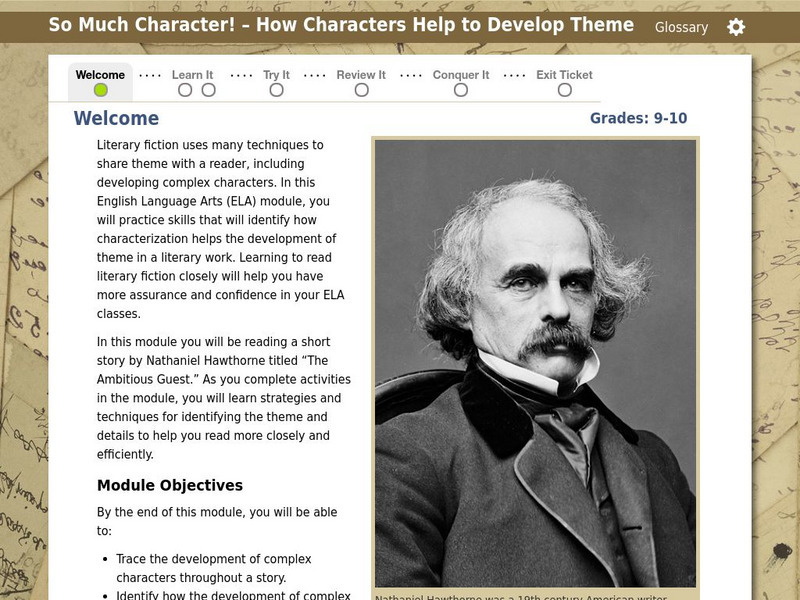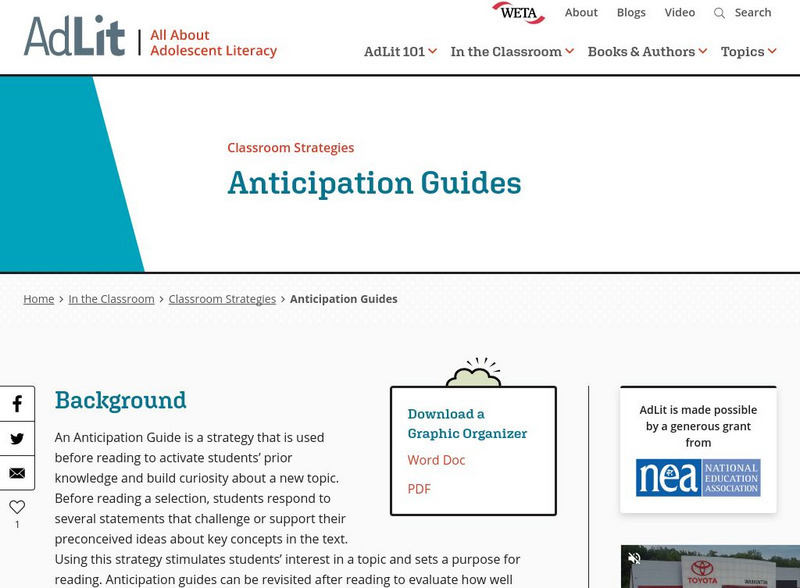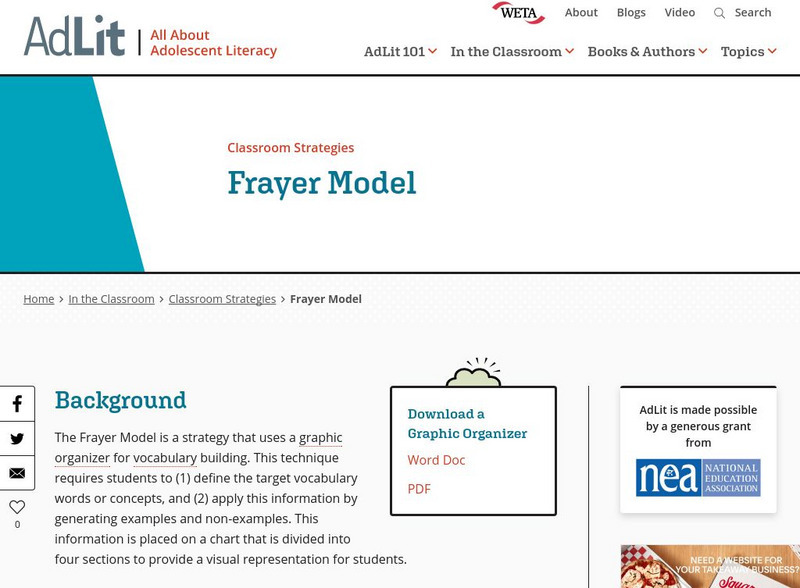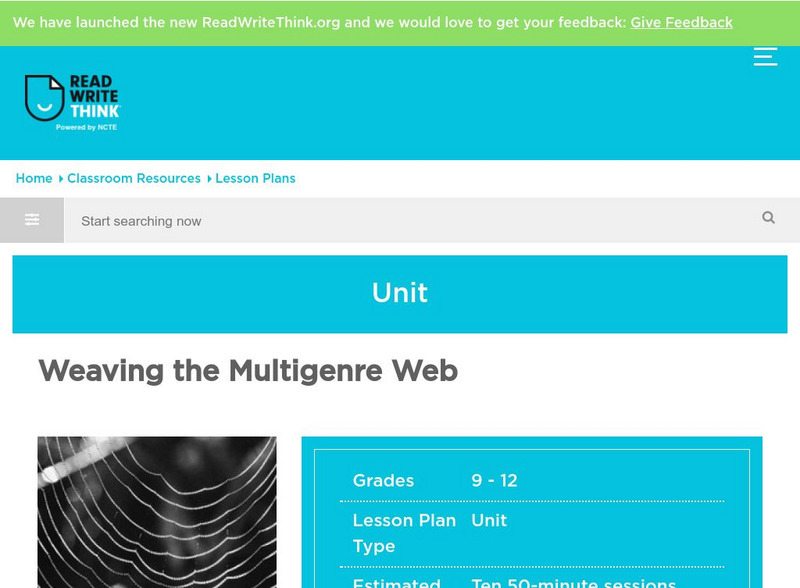Department of Defense
Do Dea: English 4; Loyalty and Betrayal
A learning module asking students to analyze fiction, examine symbolism and cultural context, read a section of The Kite Runner, practice context clues and Greek and Latin roots, and practice sentence variety with compound and complex...
Texas Education Agency
Texas Gateway: Analyze Controlling Idea or Thesis, Purpose, and Textual Elements
[Accessible by TX Educators. Free Registration/Login Required] This lesson focuses on how to locate the controlling idea and specific purpose in a text and analyze the roles they play in understanding what you read. You will analyze the...
Texas Education Agency
Texas Gateway: Understanding Literary Text: Archetypes, Motifs, & Plot in Drama
A learning module that teaches students about archetypes, motifs, and plot in six mini-lessons: Introduction, Character Archetypes, Archetypal Plot Patterns, Other Archetypal Patterns, Archetypal Motifs, and Your Turn.
Thinkport Education
Thinkport: So Much Character! How Characters Help to Develop Theme
A module to practice skills that will identify how characterization helps the development of theme in a literary work.
Thinkport Education
Thinkport: Read Like This, Too Central Ideas and Supporting Details
Begin practicing skills that will help identify the central idea and details while reading literary nonfiction.
Thinkport Education
Thinkport: Read Like This: Determining Theme in Literary Texts
In this module you will read a story called "The New Dress" by Virginia Woolf, with the purpose of determining themes and how they develop over the course of the text.
Thinkport Education
Thinkport: Revolution and the Power of Words
A module where students will determine the meaning of unfamiliar terms using prior knowledge, context clues and examination of word parts.
Thinkport Education
Thinkport: Totalitarianism in Stalinist Russia
A module where students analyze how the author uses text structure to emphasize key points or explanations in order to achieve the purpose for writing or point of view.
PBS
Pbs Learning Media: Out of Proportion
Students are asked to explain how natural disasters affect environmental health.
PBS
Pbs Learning Media: In This Together
Students are asked to explain how a crane's parts work together to achieve the end result.
AdLit
Ad lit.org: Classroom Strategies: Anticipation Guides
An Anticipation Guide is a strategy that is used before reading to activate students' prior knowledge and build curiosity about a new topic. Before reading a selection, students respond to several statements that challenge or support...
AdLit
Ad lit.org: Classroom Strategies: First Lines
First Lines is a strategy in which students read the beginning sentences from assigned readings and make predictions about the content of what they're about to read. This pre-reading technique helps students focus their attention on what...
AdLit
Ad lit.org: Classroom Strategies: Frayer Model
The Frayer Model is a strategy that uses a graphic organizer for vocabulary building. This technique requires students to (1) define the target vocabulary words or concepts, and (2) apply this information by generating examples and...
AdLit
Ad lit.org: Classroom Strategies: Concept Maps
A concept map help students visualize various connections between words or phrases and a main idea. There are several types of concept maps; some are hierarchical, while others connect information without categorizing ideas.
AdLit
Ad lit.org: Classroom Strategies: Power Notes
Power Notes is a strategy that teaches students an efficient form of organizing information from assigned text. This technique provides students a systematic way to look for relationships within material they are reading. Power Notes...
E Reading Worksheets
E Reading Worksheets: Patterns of Organization: Chronological Order
This learning module provides an explanation of the chronological order text structure. An explanation of the chronological text structure is provided, and a video tutorial lesson is provided to supplement this lesson [1:04] Additional...
Cambridge Rindge & Latin School
Cambridge Rindge & Latin School: Creating Subtopic Headings
An excellent tip sheet on how to group information after brainstorming and prewriting.
Polk Brothers Foundation Center for Urban Education at DePaul University
De Paul University: Center for Urban Education: I Can Analyze a Story or History [Pdf]
This graphic organizer can be used to help students analyze a story or a historical event. Students will look closely at the story's characters or people involved in the historical event. Then they will summarize the story or event, and...
Other
Mo Dept. Of Ed.: Analyzing and Evaluating Literary Works
Lesson plan designed for eleventh graders. Young scholars analyze and evaluate a short story for elements of literary works such as theme, mood, word choice, imagery, tone, and main idea. Includes a student handout and a scoring guide....
ReadWriteThink
Read Write Think: Graffiti Wall: Discussing and Responding to Literature
New ways of thinking about text, collaboration with group members, and presentation skills are all developed with this lesson which could be applied to almost any novel read in class. Includes student handouts, an online interactive, and...
ReadWriteThink
Read Write Think: Weaving the Multigenre Web
Students analyze the elements of a novel in many different genres and then hyperlink these pieces together on student-constructed Websites.
Annenberg Foundation
Annenberg Learner: Journey North: Reading Strategies: Compare and Contrast Ideas
This reading resource discusses the strategy of comparing and contrasting ideas. Students will learn definitions and explanations for similes, metaphors, and analogies. A list of guiding questions is provided to help students as they...
University of Victoria (Canada)
The U Vic Writer's Guide: Literary Term: Plot
This page offers a detailed overview of plot, including its various aspects and use in various types of literary works.
Curated OER
National Park Service: Elements of Literature [Pdf]
A PDF glossary listing and defining literary elements.
















